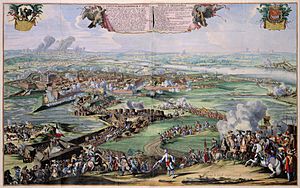Siege of Philippsburg (1676) facts for kids
Quick facts for kids Siege of Philippsburg |
|||||||
|---|---|---|---|---|---|---|---|
| Part of the Franco-Dutch War | |||||||
 The siege of Philippsburg |
|||||||
|
|||||||
| Belligerents | |||||||
| Commanders and leaders | |||||||
| Charles V of Lorraine Frederick VI, Margrave of Baden-Durlach |
Charles de Faultrier du Fay | ||||||
| Strength | |||||||
| 40,000 | 2,800 | ||||||
| Casualties and losses | |||||||
| Unknown | 1,300 | ||||||
The siege of Philippsburg was a major event during the Franco-Dutch War. A siege happens when an army surrounds a city or fortress to cut it off. The goal is to make the people inside surrender. This siege took place at the fortress of Philippsburg in what is now Germany.
Why Philippsburg Was Important
Philippsburg was a very important fortress for France. Since 1644, it had been a French stronghold on the east side of the River Rhine. Think of it as a key crossing point or a "bridgehead" that allowed French armies to move easily across the river. A famous engineer named Vauban had made it very strong.
This fortress was a constant threat to the Holy Roman Empire. The Holy Roman Empire was a large group of states and kingdoms in central Europe. Philippsburg was a French base that allowed them to launch attacks into nearby areas.
The Siege Begins
In the spring of 1676, smaller French bases near Philippsburg were captured. Because of this, the Holy Roman Empire decided to attack the main fortress itself.
On June 23, Charles V, Duke of Lorraine, led a large army of 40,000 soldiers from the Holy Roman Empire. They surrounded Philippsburg. Inside the fortress, the French commander Charles de Faultrier du Fay had only about 2,800 men.
The Fight and Surrender
The French tried to send help to the soldiers trapped inside Philippsburg, but their efforts failed. With no hope of getting more supplies or troops, the French commander du Fay had to surrender. This happened on September 17, 1676.
About 1,500 French soldiers survived the siege. They were allowed to march out of the fortress with full military honors. This means they were treated with respect, even though they had lost.
After the siege, 3,000 soldiers from the Holy Roman Empire took control of Philippsburg. The fortress stayed in their hands for a while. However, France recaptured it later in 1688 during another conflict.

